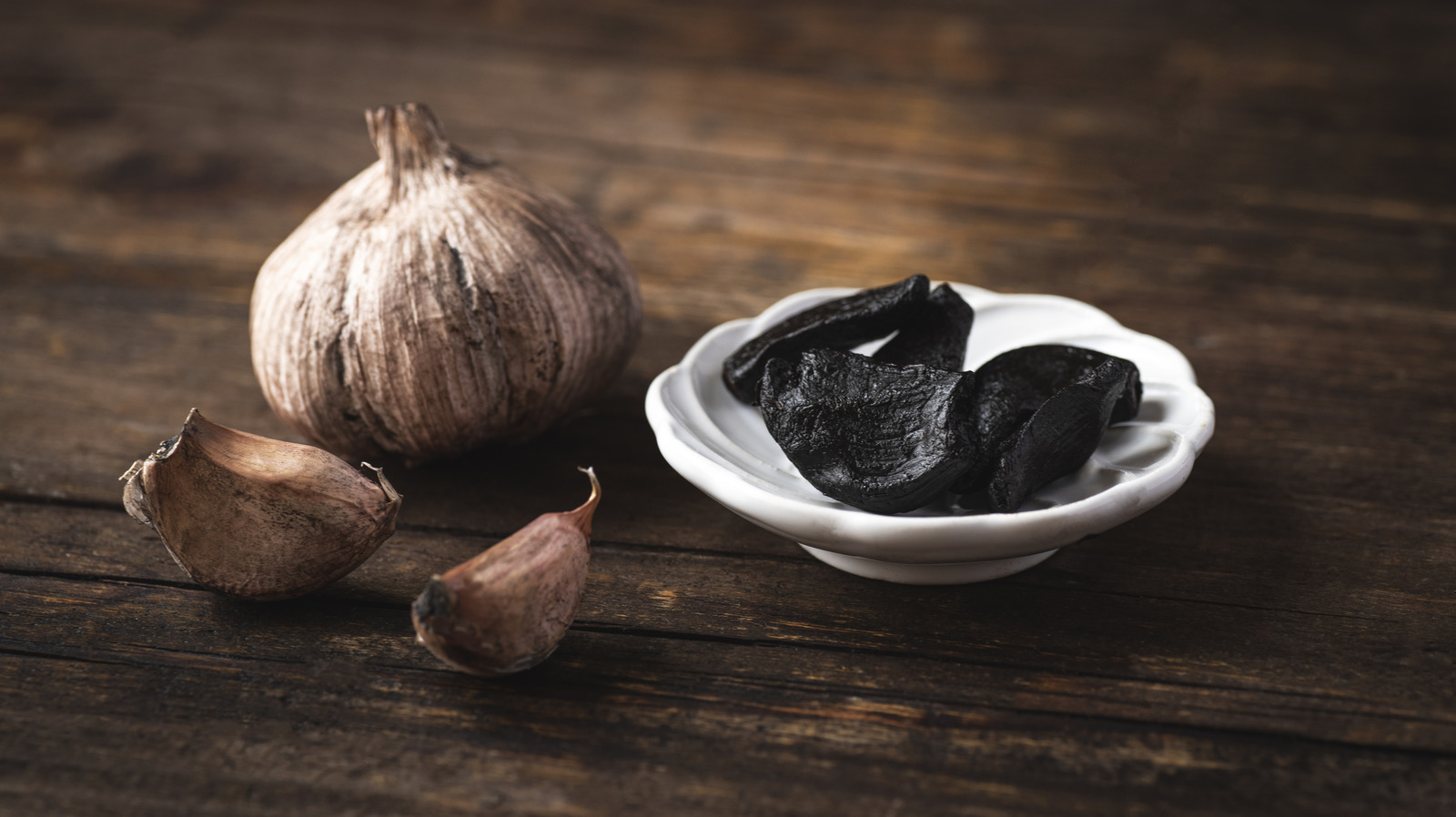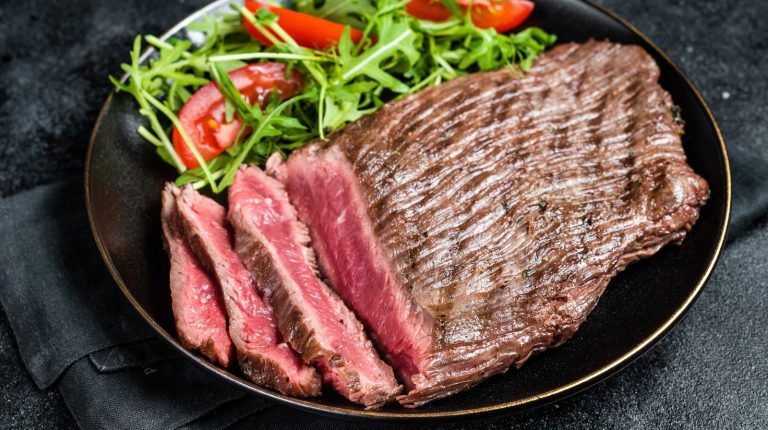We may receive a commission on purchases made from links.
If you have spent any length of time in the kitchen, you are probably more than familiar with garlic. This beloved allium is found in an array of different cuisines, from Asian to Mediterranean, and almost just as many dishes. While garlic has gotten its fair share of time in the limelight, it has pushed other derivatives of it — like black garlic — to the wayside.
If you look at a black garlic clove and a normal garlic clove side by side, you can already tell the difference. Not only is their color very different, but black garlic cloves look shrunken in their peels, which is the result of a long curing process — not fermenting, as many people assume. Black garlic smells a lot like it tastes — with underpinnings of balsamic vinegar, molasses, tamarind, and caramelized onions. It’s complex, funky, and sweet in the best possible way, and if you haven’t tried it before, you may not know what you’re missing.
In an effort to give this cured allium some attention, we made a list of some of our favorite ways to use it. It’s important to note that, while you can find whole black garlic in Asian markets or through online retailers, some of these uses may be better suited to black garlic products like paste, salt, or powder, so use discretion when selecting which one to add to your recipe.
Add it to your barbecue sauce
You might be familiar with the usual components of homemade barbecue sauce: vinegar, molasses, ketchup, and the like. The next time your store-bought selection needs improvement, consider adding a little black garlic to it. Black garlic is an umami powerhouse that can save a bland sauce — though you shouldn’t use it just for this elusive flavor. Rather, black garlic also has an inherent sweetness that pairs well with ingredients like brown sugar and honey. This sweetness will also help soften any astringent notes, which can be helpful if you’re working with a bold, vinegar-forward sauce.
The flavor of black garlic is mild enough that you likely won’t be able to pick up on it specifically in your sauce, especially if it’s in good company with the aforementioned ingredients. To ensure that your sauce comes out creamy and chunk-free, we recommend using a black garlic paste rather than chopping up the whole, sticky cloves and tossing them in. It’ll also save you the troubles of cleaning off a tacky knife blade.
Infuse it into your ketchup
The key to working with black garlic is to give it a vehicle to deliver its flavor, rather than just adding the cloves into your recipe and hoping for the best. This is precisely why black garlic ketchup deserves a spot in your fridge.
Ketchup already contains a Rolodex of black garlic-compatible ingredients, including umami-rich tomato paste, sweet sugar, and punchy vinegar. The black garlic will highlight the profile of each respective ingredient and give your condiment, as a whole, a deeper flavor. You can purchase this ingredient from a specialty grocer, or, if you want to save a few bucks, try using a 3-to-1 ratio of ketchup to black garlic paste.
Some sources will recommend using the black garlic as a total replacement for a sweetener, but we’d argue that its sweetness alone is not enough to carry the whole sauce. So, you may need to add extra sugar if you’re making your ketchup base from scratch. There are seemingly endless ways to use black garlic ketchup, from a topping on meatloaf and ribs and a glaze for chicken wings to a dipping sauce for french fries.
Incorporate it into your desserts
If you’re a person who can’t say no to a sweet-and-savory dessert mashup, now is your chance to take this obsession to a new level. While you may not ever want to use regular garlic in a cookie or brownie recipe, black garlic offers a unique opportunity thanks to its molasses-like sweetness and subtle umami notes.
It’s important to note that the black garlic cannot replace sugar in your dessert — especially because sweeteners are important, not just for flavor, but also for getting the perfect texture in your dessert (hence why making sugar-free ice cream is harder than it looks). You can infuse black garlic into your custard for an ice cream or a panna cotta, or use it to make a dessert sauce for your bread pudding or cheesecake. If you like the timeless salted caramel combination, you might also want to try a black garlic caramel sauce; the umami flavor of the allium will tone down the cloying, toffee-like sweetness of the caramel.
Mix it into your salad dressing
Adding garlic to homemade salad dressing is a no-brainer. If you’re after a sweeter profile that doesn’t abandon savoriness entirely, then you may want to try adding black garlic to your recipe. Your dressing will be elevated by the date-like flavor of the black garlic. If you’re utilizing punchy ingredients like Dijon mustard or vinegar in your dressing, you’ll find that the umami notes are able to balance both the astringent flavors in your dressing and whatever you’re using it on – be it roasted veggies, cold pasta, or classic salad staples like greens, tomatoes, and onions.
You have to be a little creative when adding this ingredient to your dressing — since no one wants to bite into a tacky chunk of black garlic that’s clinging onto a crouton for dear life. Instead, try swapping your standard extra virgin olive oil with a black garlic-infused oil or mash your cloves into a paste before mixing it with the rest of the dressing ingredient. We find black garlic works well on any salad you would normally dress with a balsamic vinaigrette.
Infuse it into oil
For all its merits, the one drawback of black garlic is its texture. It’s tacky and feels like spent chewing gum on your molars. Luckily, there are ways to extract those beautiful flavors without having to undergo the sensory experience of biting into a clove.
Infusing oil seems relatively easy to do, but it does carry risks. Low-acid foods suspended in an anaerobic environment (oil) can be a formula for botulism. So, you’ll need to acidify any ingredients you plan to add to the oil and keep the temperature low to stave off this food-borne illness. We recommend following a trustworthy recipe to make this oil and following all necessary precautions to reduce your risk of ingesting this potentially deadly toxin.
You can use the infused oil for a whole host of recipes that you want to bring a little hint of sweetness and umami, but not wallop your palate with it. Try serving it with crusty bread or drizzling a little bit into your hummus.
Rim your cocktail glass with black garlic salt
If you are a big fan of savory cocktails, you’re going to love this fun twist. Using black garlic in or as a rim for your cocktails will introduce tons of umami flavor and complement the notes already in your drink. Take the quintessential savory (and umami) cocktail, the Bloody Mary, for example. The tomato juice, Worcestershire sauce, and hot sauce create a flurry of flavors on your palate, and adding a little bit of black garlic to the party makes them all the more intense.
Add a little bit of black garlic paste to your Bloody Mary mix, stirring well, for a contrasting sweetness and complementary savoriness that will make this brunch staple all the more memorable. To make your black garlic rim, pick up or order a container of flaky black garlic salt, wet the rim of your glass just enough, and roll it in the garnish.
Mix it into your pasta sauce
Pasta sauce and garlic go hand in hand, so it’s not too far off to see how adding black garlic can give your sauce an unexpected burst of flavor. A basic marinara sauce that runs a little too acidic can be easily corrected with some black garlic. You can either chop up the garlic cloves very finely or stir a paste directly into your sauce. When we use black garlic for our sauce, we like to let it simmer down for a while so that the allium has ample time to infuse into the sauce.
Classic marinara isn’t the only sauce that could benefit from a little black garlic twist. A creamy Alfredo could be easily enhanced by a hint of it, as the umami flavor will complement cheeses like pecorino and Parmesan, while also cutting through the richness of the sauce. You can also use it to increase the umami undertones of a savory ragù or mushroom-based sauce, or use it to ground the flavor of an herby pesto.
Dress your roasted veggies with it
Roasted veggies are one of the simplest and most satisfying side dishes ever. While raw vegetables aren’t anything special, they transform into something magical when they’re doused in oil and roasted until crispy. But serving your Brussels sprouts, mushrooms, cauliflower, and even potatoes solo isn’t enough — you need to add a flavorful sauce to help bring out those roasty-toasty flavors.
Black garlic is a great addition to your roasted veggie dressing because it offers both sweetness and umami. Brussels sprouts, for example, are often dressed with a balsamic glaze. Black garlic’s flavor parallels balsamic but has a slightly more robust umami profile, making it a great pairing for this divisive veggie. Make a sauce with black garlic paste and drizzle it on charred and crispy sprouts, or infuse some black garlic into your balsamic reduction to enhance the allium’s flavor even more. Another vegetable black garlic lends itself well to is carrots. When carrots are roasted, their sweetness intensifies, which works off the garlic’s molasses undertones.
Add it to aioli
Aioli is a fancier and more flavorful version of mayonnaise. While many standard homemade aioli recipes amp up the citrus, using black garlic as the primary flavor enhancer is also an excellent option. Not only will the black garlic make the aioli taste richer and more satisfying, but the aioli also stands in as the perfect creamy vector to deliver this sauce to your favorite foods. You can serve aioli as a dipping sauce for french fries and onion rings, or slather it on your burger or breakfast sandwich.
Black garlic makes a great alternative to regular garlic if you aren’t a fan of the fresh allium’s bite. It’s much milder and sweeter, so if you like the punchiness of a traditional garlic aioli, you might want to consider using the two in tandem. Add in your mashed black garlic cloves with the rest of your aromatics and seasonings; you may want to opt for black garlic paste for a creamier spread. Be sure to also emulsify the sauce properly so it won’t break. While it may take a few tries, especially if you’re an aioli novice, the subtly sweet and savory sauce that results will be well worth the effort.
Use black garlic to flavor your bread
Focaccias, boules, and flatbreads, oh my! Once you master the basics of bread baking, there is so much potential for exploration. Black garlic, and alliums in general, are a safe place to start. The cured garlic’s flavor will offer a subtle sweetness to your bread recipe, though most of its profile is still in line with other savory seasonings like thyme, rosemary, salt, and pepper. You can use it in savory bakes and leverage its molasses undertones to round out the flavor of your bread. Focaccia is a great place to start, as you can stud the bread with pieces of black garlic, along with other add-ins like olives, feta, and herbs.
Another place where black garlic shines is in rolls or pull-apart breads. The black garlic offers just enough flavor to be noticeable, and you’ll also get the perfect little nuggets of black garlic interspersed throughout your buns. Alternatively, you can also add a sprinkle of black garlic powder to flavor your bread, though we have found that it tends not to have the same punchy flavor as the whole cloves. Black garlic would be a great pairing for any umami-rich cheese, like Parmesan, as well as tasty add-ins like miso paste, sun-dried tomatoes, and nuts.
Turn it into a compound butter to make it easier to spread
Compound butters might sound like a challenge, but they’re actually one of the easiest and most worthwhile recipes to make at home. You can add your softened butter to a stand mixer along with your black garlic — both paste and chopped cloves work — and mix it until well incorporated. Stick to just black garlic so that you can get a better sense of its flavor before adding other flavorings, like fresh thyme, rosemary, or regular garlic. Once the fat is well mixed, transfer it to a piece of wax paper and let it firm up in the fridge before serving.
You can use compound butter in almost any instance where you would use regular butter. For one, your black garlic compound butter would be an excellent way to adorn a juicy steak, as the umami flavor would seep down into the cut and infuse it with enough sweetness to complement its char. You could also add a little bit to the pan before cooking eggs or swipe a pat on a piece of toast, grilled cheese, or sandwich of choice.
Add it to your favorite meat marinade
Marinades can be the secret to unlocking better flavor and texture from your protein of choice. While adding black garlic won’t help denature the proteins and soften your steak or chicken like acids — including vinegar or lemon juice — would, it will still add a delightful flavor and amp up the umami.
You can add black garlic to a range of regional marinades, including Asian, Mediterranean, or classic Southern. It’s not as sharp as garlic and will instead offer a complementary, pared-down sweetness perfect for pairing with umami-forward sauces and ingredients like Worcestershire sauce, soy sauce, fish sauce, or miso paste. The sweetness can also tamp down the acids and make the marinade’s flavor a little more well-rounded.
Try adding black garlic paste to a shrimp marinade made with lime juice, fish sauce, soy sauce, and aromatics like ginger and garlic. You can also add it to a pork marinade paired with maple syrup, brown sugar, or molasses. It would be an incredible match for juicy pork chops.
Mix it into your risotto
Risotto is a great cold-weather dish to whip up, provided that you have the patience to incrementally add stock and simmer your rice. We love adding mushrooms to our recipe because their umami flavor is the perfect springboard for herbs like thyme and sage, and that decadent sprinkle of Parmesan cheese — the real reason risotto is worth eating.
Black garlic is the perfect conduit for sweetness and savoriness in a risotto, and you don’t have to add a ton of it for it to be effective. Grab a couple of cloves, mince them, and add them to your stock along with your mushrooms and aromatics. Black garlic doesn’t need to be sautéed or cooked down in the same way that normal garlic does, so you’re set to add it in when you start simmering your risotto away.
The cured garlic is in good company with common risotto ingredients, including a splash of white wine, Parmesan, and even a sprinkle of goat cheese if you fancy its flavor. Pair it with a pinot noir for easy sipping, or go for a mild chardonnay if you want to highlight the dryness of the Parmesan.
Flavor your pan sauce with black garlic
Fond, the stuff leftover in the pan after you cook meat, is like the gift that keeps on giving. If you’re washing your pan immediately after transferring your seared steak, chicken breast, or the like, you could be missing out on a ton of flavor and a decadent pan sauce. Black garlic is an excellent addition to a range of pan sauces, including gravies, piccatas, and marsalas. You can never have too much savoriness and umami in a pan sauce, and black garlic will just compound and intensify what’s already there. Its sweetness also lends itself well to a range of aromatics, including regular garlic and shallots.
One simple way to get your footing with this unique and punchy ingredient is to try a mushroom pan sauce for your steak. The woodsy flavors of the mushrooms will amplify the balsamic-like flavor of the black garlic and offer a residual sweetness, which will work in perfect harmony with the crispy, almost-caramelized exterior of your cut.
Use it as a flavoring in your favorite dips
Dips are a great place to experiment with black garlic. There are so many different kinds out there, from salsa and guacamole to whipped feta and blue cheese dips, so you have room to experiment and play with flavors.
When you’re just starting out, look for shared flavor profiles between the dip and the black garlic. Hummus, for example, is the perfect blank canvas to add black garlic-infused oil to instead of a plain olive oil. You can also blend the whole cloves into the spread; The food processor or blender will make quicker work of the sticky cloves than a plain knife. Black garlic is also in good company with tomato and pepper-adjacent dips — like a roasted red pepper hummus or romesco — because the spice will push those acidic and piquant flavors to the forefront while also supplementing the savory underpinnings.




